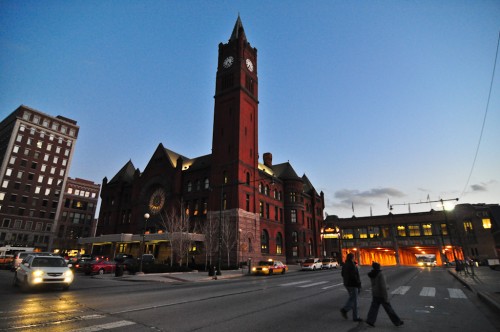
Last week, I was asked to speak at an Envision Broad Ripple (EBR)Â meeting. EBR, is a community effort being put forth to change the future of Broad Ripple’s built environment. They are looking at an entirely new zoning structure, and it will be based upon a vision now being developed by community leaders, as well as residents. I was asked to come in and speak about my recent trip to Portland and what I learned at Railvolution. It had particular significance in that they are currently looking at density in the village. Transit is an important component of building density in an urban area.
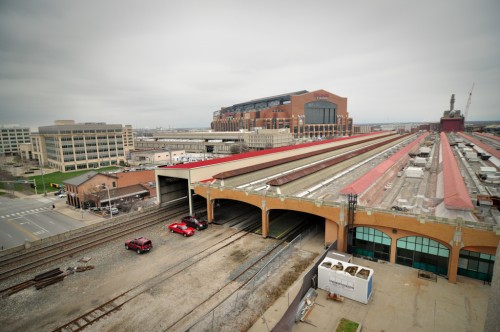
I thought that it would be an interesting way to frame my latest argument with the Indyconnect plan. I call it, “Envision Union Station”. In light of the news that there would be two commuter lines eventually closing at this hallowed facility, I thought that we should reaxmine just what Union Station currently looks like. By now, anyone reading know’s that I am staunchly firm in my support that Washington Street should have light rail before either of the two commuter lines are built, but let’s say for the sake of argument, that we are stuck with this plan. Now, how do we get people to ride these commuter lines, what route do the trains travel to get there, what geographic obstacles are there to overcome, and just what does Union Station look like these days? For the sake of bounding the argument, this post will only examine the downtown area, and not the specific routes outside of that area.
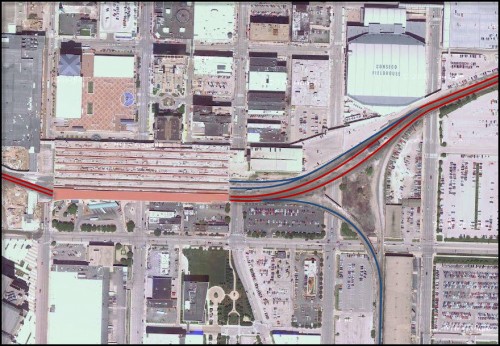
The plan as it stands, calls for usage of the old Nickel Plate line that is adjacent to the Monon Trail, at which point, it would cross a bridge at 10th street and in some form either use the CSX freight lines, or move those lines over and use a single track from there, to Union Station. As this is a very detail oriented decision on how to properly get trains routed from 10th street to Union Station, no plans have been announced about which platform would be utilized inside of Union Station. However, it could be expected, that the two northern most tracks would be used, as they currently are for Amtrak’s 4 times weekly Hoosier State train; which is scheduled to depart at 6am on those mornings. Also worthy of note, is that CSX operates 25-30 freight trains every 24 hours through the Indianapolis area via downtown’s tracks. Scheduling commuter trains between the freight traffic could prove problematic unless a good plan is put in place by planners and CSX officials.
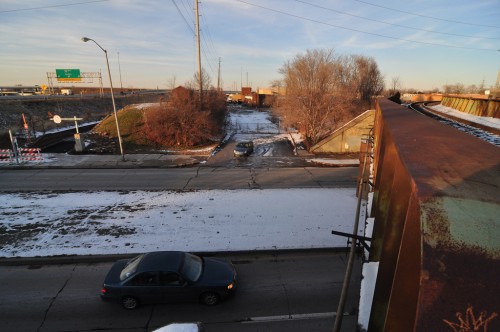
The trains that would hail from the south side, are planned to use existing freight lines owned by the Louisville & Indiana Railroad Company. This too, is currently a single track line that sees roughly one freight train a day. The speculation is that Indianapolis would offer to upgrade the lines upon which commuter lines would operate in exchange for a smaller operating fee paid to L&I. As you can see, negotiating with L&I would offer Indianapolis the upper hand in suggesting a would be cohabitation plan for frieght and commuter train traffic. I find the biggest obstacle for the southern alignment is getting across the current alignment of the through CSX freight lines.
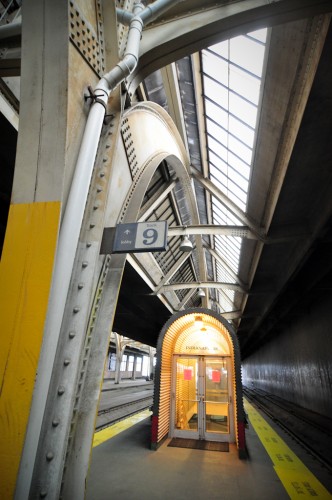
The next part of the equation, is how do we efficiently get people from Union Station, to their places of work? Since the platform is located on what is effectively the 2nd story, stairs are provided to get travellers from the platform to the lower level which is also a depot for Greyhound buses. The only currently used stairwell, is a single door from the platform down to ground level on a switch back stairway. It stands to reason that more stairways could be re-opened to allow a more free-flow of people.
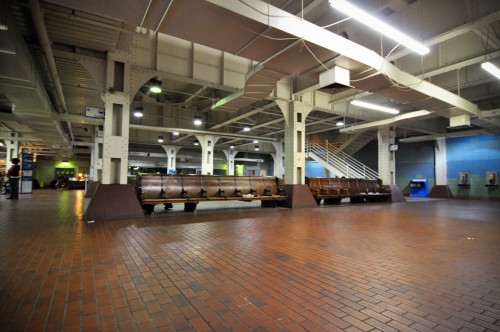
Once people have arrived at ground level they will be greeted by the image above. A largely industrial looking room lit by artificial light and painted in a dull white. It is currently littered with wooden benches for people waiting on buses. Exploring how far people will have to walk to major downtown destinations is also in order. Approximately 3/4 mile to the city-county building. 1/4 mile to the Capitol, and 1.5 miles to IUPUI’s campus center. Other downtown employment center’s include Lilly, Wellpoint and others are within similar walking distance. Luckily, the Cultural Trail will open along Capitol Ave soon, and provide a safe place for would-be commuters to get along streets on that side of downtown. A downtown circulator bus could also be put into place which would serve commuters.
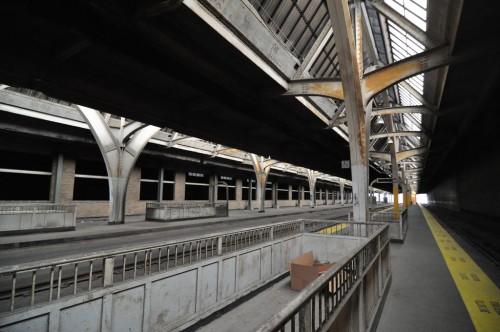
One last point about Union Station itself is this. What are people going to think when they arrive? In it’s current state, platform level appears as a dark and unkept location. When I took the photographs in this post, there were many pieces of garbage strewn about, and it was dark. Natural light is kept to a minimum due to hazy overhead skylighting and an abundance of superstructure supporting it. Some house keeping alone might make it attractive to people, but dispelling the image of a dark 2nd story downtown train station loading zone would go a long way to enticing people onto the commuter trains. I wonder if any renovations of Union Station are figured into the Indyconnect budget….
I actually think Union Station looks gorgeous, although it obviously needs some serious renovation. I think by adding some fresh paint, cleanup, some artwork, and clearing out those skylights with some good artificial lighting, it could be a top-notch station that I would definitely ride from Fishers to Indy, then pick up a bus to IUPUI.
How’s the proposed new Bus/Future Train Hub across from Lucas Oil Stadium (I believe the Post Office Building?) work into this? Has those talks been put to rest?
As far as I know, that is off the table. Who knows though. The study that concluded that, was done in 2006. In 2008, another study was commissoined. Ive inquired repeatedly, but with Indyconnect putting a box around all recent plans, its sort of in flux. As you can see from the Indyconnect plan, there was not really a mention about this “downtown transit center” as it was called. So who knows.
In regards to circulators, there only appears to be one planned downtown and it looks like the current red line service. That worries me. It’s difficult to get much detail out of the website maps too.
Yah, it makes me think this Indy Connect Initiative is a ‘transit policy shortcut’ as Ballard’s big political stunt? Not sure what to think. I guess the talk is a start…regardless of the plans’ substance.
Curt, you did a great job at the EBR meeting. Thanks for your thinking on transit!
Thank you for your presentation on EBR. Portland is a beautiful city that has a lot going for it regarding transit. It was good for people who had never been there to be exposed to what is possible.